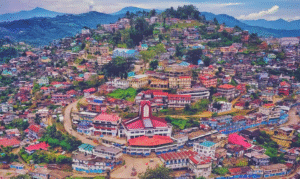Introduction
Perched high in the Lushai Hills of northeastern India, Aizawl, the capital of Mizoram, offers a compelling blend of natural beauty, cultural richness, and historical depth. Established in 1890 as a British military outpost, Aizawl has since evolved into a thriving urban centre that reflects the essence of Mizo identity. Surrounded by green valleys, misty mountains, and traditional village settlements, Aizawl captivates with its scenic views and enduring heritage. From being a quiet colonial establishment to becoming the political and cultural heartbeat of Mizoram, Aizawl’s story is a testimony to resilience, adaptation, and ecological harmony.
This blog explores the educational, cultural, historical, environmental, and socio-economic dimensions of Aizawl, highlighting why it is not only the administrative capital of Mizoram but also its spiritual and ecological soul.
Geographic Setting and Scenic Landscape
Aizawl is located at an altitude of approximately 1,132 meters (3,715 feet) above sea level. The city spreads along the ridges of steep hills and overlooks the lush green Tlawng River valley to the west and the Tuirial River valley to the east. The topography gives Aizawl a unique layout: houses are perched on hillsides, and roads wind along mountain edges. This positioning offers breathtaking panoramic views of valleys, forests, and distant blue hills.
The climate is moderate throughout the year, with cool winters and pleasant summers. Misty mornings, clear blue skies, and abundant flora give the city a serene and mystical charm. The presence of flowering trees, bamboo groves, and chirping birds makes Aizawl a living sanctuary amidst urban expansion.
Historical Background
The history of Aizawl is closely linked to the broader history of Mizo society. Before the British arrival, the Mizo tribes practiced a form of village autonomy, governed by chieftains. In 1890, during a British expedition to control tribal resistance, Aizawl was chosen as a strategic military outpost. Gradually, administrative buildings, schools, and churches were established, transforming the hilltop into a structured township.
The Presbyterian missionaries, notably from Scotland, played a vital role in developing education and religious life in Aizawl. Schools were established for tribal children, and the Roman script was adapted to write the Mizo language. By the mid-20th century, Aizawl became a prominent centre of learning and religious devotion, especially for Christian denominations.
The Mizo National Front (MNF) uprising in the 1960s, aimed at achieving independence for Mizoram, led to significant conflict in the region. However, with the Mizo Peace Accord of 1986, Mizoram became a full-fledged state, and Aizawl was formally declared its capital. Since then, Aizawl has experienced peaceful growth and democratic consolidation.
Cultural Landscape
Aizawl is the cultural heartbeat of Mizoram. The majority of its population comprises the Mizo ethnic groups, including sub-groups like the Lusei, Hmar, Paite, and Ralte. The Mizo identity is shaped by oral traditions, music, folklore, and Christian values.
The city hosts a range of cultural events, most notably:
- Chapchar Kut – Celebrated in spring after the jungle clearing for jhum cultivation, this is the most vibrant festival of Mizoram, showcasing traditional dances like Cheraw (bamboo dance), music, and local cuisine.
- Christmas and Easter – As the majority of the population follows Christianity, these festivals are celebrated with devotion and community feasts.
- Independence Day & Statehood Day – These are marked by official parades, cultural performances, and tributes to Mizoram’s journey toward autonomy.
The city is also known for its traditional handloom and textiles. Mizo women, particularly in Aizawl, weave intricate patterns in shawls and puans (traditional wraparounds), using looms in their homes. These fabrics often symbolize clan identity and social status.
Urban Planning and Architecture
Due to its hilly terrain, Aizawl’s urban development is vertical rather than horizontal. Buildings are often multi-storeyed and constructed on stilts to accommodate the steep slopes. The city’s architecture is a blend of modern construction and vernacular elements. Government offices, educational institutions, and religious buildings dominate the city skyline.
The central areas, such as Zarkawt, Bawngkawn, and Chaltlang, are hubs for commerce, transportation, and governance. Residential zones expand from the city centre into hillside colonies. Despite rapid urbanization, there is a deliberate effort to preserve green belts, maintain ecological balance, and limit deforestation.
Educational Institutions and Literacy
Aizawl has emerged as an educational nucleus in Mizoram. The state boasts one of the highest literacy rates in India, and Aizawl contributes significantly to this achievement. Key institutions include:
- Mizoram University – Established in 2001 as a central university, it offers undergraduate, postgraduate, and doctoral programs across disciplines such as social sciences, natural sciences, management, and engineering.
- Pachhunga University College – One of the oldest colleges in Mizoram, known for its academic excellence.
- Aizawl Theological College – Important for religious studies and theological research.
Schools in Aizawl follow both the Mizo Board of School Education (MBSE) and CBSE curriculum. English is widely used as a medium of instruction alongside the Mizo language. The emphasis on education, especially among women, is a defining feature of the city.
Religious and Spiritual Life
Christianity plays a dominant role in shaping the spiritual ethos of Aizawl. The city has numerous churches, some of which are architectural landmarks:
- Solomon’s Temple – A magnificent structure resembling the biblical temple, known for its unique design and grandeur.
- Presbyterian and Baptist churches – Spread across the city, often conducting community prayers, youth programs, and Bible study sessions.
The city observes Sundays as days of rest and worship, with businesses shut and roads less busy. Community harmony, moral discipline, and collective spirituality form the bedrock of Aizawl’s social life.
Economy and Livelihood
The economy of Aizawl is driven by a combination of government employment, small-scale trade, agriculture, and handicrafts. As the capital city, it hosts the secretariat and offices of various state departments, employing a large segment of the population.
Additionally, there is a growing presence of:
- Retail businesses – Including markets like Bara Bazar and New Market, where local produce, clothes, and crafts are sold.
- Handloom and bamboo crafts – Many families engage in home-based weaving and craft production.
- Tourism – Scenic beauty, mild climate, and cultural hospitality are attracting both domestic and international tourists.
Efforts are being made to promote entrepreneurship among Mizo youth, especially in sectors like eco-tourism, IT services, organic farming, and food processing.
Transportation and Connectivity
Due to its terrain, Aizawl faces unique transportation challenges. However, the city is connected via:
- Lengpui Airport – Located about 35 km from the city, it connects Aizawl to Guwahati, Kolkata, and other regional cities.
- Roadways – The city is connected to national highways, and internal movement is facilitated through minibuses, taxis, and two-wheelers.
- Helicopter services – Operated by Pawan Hans, they connect Aizawl to remote locations within the state.
Although the absence of a railway station is a limitation, infrastructure projects are underway to enhance connectivity and reduce logistical bottlenecks.
Environmental Awareness and Sustainability
Aizawl stands as a model of eco-conscious living. The local community, driven by strong civil society engagement and religious teachings, participates actively in cleanliness drives, waste management, and forest conservation.
Organizations such as the Young Mizo Association (YMA) and Mizo Hmeichhe Insuihkhawm Pawl (MHIP) mobilize residents for afforestation, cleanliness, and disaster relief.
Rainwater harvesting, solar panel installations, and minimal use of plastic are promoted at household and institutional levels. Urban planning in Aizawl consciously integrates environmental safeguards, reflecting a harmonious balance between development and nature.
Tourist Attractions in Aizawl
Though compact in size, Aizawl offers various attractions for visitors:
- Durtlang Hills – Provide scenic views of the city and are ideal for trekking.
- Mizo Hlakungpui Mual – A memorial for legendary Mizo poets and writers.
- Mizoram State Museum – Showcases traditional artifacts, musical instruments, and tribal attire.
- KV Paradise – A mausoleum built in memory of a beloved wife, often referred to as the “Taj Mahal of Mizoram.”
- Reiek Heritage Village – Though located a short drive from Aizawl, it features traditional Mizo houses and offers cultural insights.
These attractions, combined with the city’s hospitality, make Aizawl an enriching destination.
Challenges and Future Outlook
Aizawl, like many hill cities, faces challenges such as landslides during monsoons, traffic congestion, and limited expansion space. However, urban resilience is growing, supported by policies that emphasize disaster preparedness, infrastructure modernization, and youth empowerment.
The future of Aizawl lies in:
- Promoting sustainable tourism
- Strengthening digital infrastructure
- Expanding higher education and research
- Supporting indigenous entrepreneurship
- Maintaining cultural integrity amidst globalization
Aizawl’s commitment to balancing modern aspirations with traditional values ensures that its development remains inclusive and eco-sensitive.
Conclusion
Aizawl is much more than just a state capital—it is a cultural sanctuary, a green haven, and a model of peaceful coexistence. Its scenic beauty is matched by its deep-rooted cultural consciousness and progressive social values. Whether it is the sound of church choirs echoing across hills or the sight of handwoven puans fluttering from balcony railings, Aizawl tells a story of harmony, resilience, and quiet strength.
As the city moves forward, embracing change while honouring its past, it remains a beacon for other northeastern cities—a reminder that development need not come at the cost of identity or environment.






